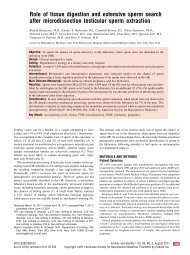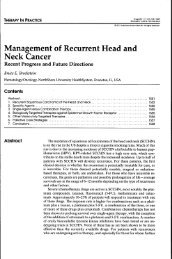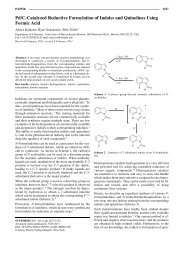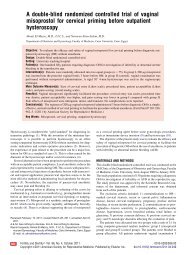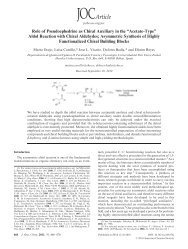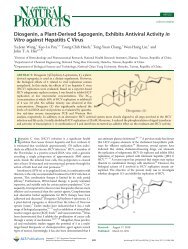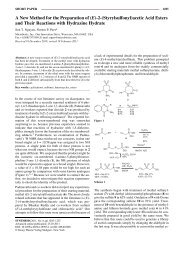Meanings of food, eating and health in Punjabi families living in ...
Meanings of food, eating and health in Punjabi families living in ...
Meanings of food, eating and health in Punjabi families living in ...
Create successful ePaper yourself
Turn your PDF publications into a flip-book with our unique Google optimized e-Paper software.
Article<br />
<strong>Mean<strong>in</strong>gs</strong> <strong>of</strong> <strong>food</strong>, <strong>eat<strong>in</strong>g</strong> <strong>and</strong><br />
<strong>health</strong> <strong>in</strong> <strong>Punjabi</strong> <strong>families</strong> liv<strong>in</strong>g<br />
<strong>in</strong> Vancouver, Canada<br />
Gwen E Chapman a , Svetlana Ristovski-Slijepcevic a <strong>and</strong><br />
Brenda L Beagan b<br />
a Food, Nutrition <strong>and</strong> Health, University <strong>of</strong> British Columbia, Canada<br />
b School <strong>of</strong> Occupational Therapy, Dalhousie University, Canada<br />
hej<br />
Health Education Journal<br />
70(1) 102–112<br />
© The Author(s) 2011<br />
Repr<strong>in</strong>ts <strong>and</strong> permission: sagepub.<br />
co.uk/journalsPermissions.nav<br />
DOI: 10.1177/0017896910373031<br />
hej.sagepub.com<br />
Abstract<br />
Objective: South Asians liv<strong>in</strong>g <strong>in</strong> western countries have <strong>in</strong>creased risk for develop<strong>in</strong>g diet-related chronic<br />
disease compared to Caucasians <strong>of</strong> European heritage. To <strong>in</strong>crease underst<strong>and</strong><strong>in</strong>g <strong>of</strong> social <strong>and</strong> cultural factors<br />
associated with their <strong>food</strong> habits, this study exam<strong>in</strong>ed the mean<strong>in</strong>gs <strong>of</strong> <strong>food</strong>, <strong>health</strong> <strong>and</strong> well-be<strong>in</strong>g embedded<br />
<strong>in</strong> the <strong>food</strong> practices <strong>of</strong> <strong>families</strong> <strong>of</strong> <strong>Punjabi</strong> heritage liv<strong>in</strong>g <strong>in</strong> Metro Vancouver, Canada.<br />
Design: Qualitative research design.<br />
Sett<strong>in</strong>g: Metro Vancouver, British Columbia, Canada.<br />
Method: Data collection <strong>in</strong>cluded <strong>in</strong>dividual <strong>in</strong>terviews with 39 members <strong>of</strong> 12 <strong>families</strong> <strong>of</strong> <strong>Punjabi</strong> Sikh<br />
orig<strong>in</strong> (ages 13 to 70 years) <strong>and</strong> participant observation <strong>of</strong> a grocery shopp<strong>in</strong>g trip <strong>and</strong> family meal. Themes<br />
were generated through constant comparative analysis <strong>of</strong> transcripts to describe, organize <strong>and</strong> <strong>in</strong>terpret<br />
<strong>in</strong>fluences on participants’ <strong>food</strong> decision-mak<strong>in</strong>g <strong>in</strong> <strong>families</strong>.<br />
F<strong>in</strong>d<strong>in</strong>gs: Participants’ descriptions <strong>of</strong> their <strong>eat<strong>in</strong>g</strong> habits were characterized by contrasts between<br />
elders’ reliance on traditional Indian <strong>food</strong>s <strong>and</strong> young people’s desire for their diets to <strong>in</strong>clude at least some<br />
‘western’ <strong>food</strong>. Participants articulated two different underst<strong>and</strong><strong>in</strong>gs <strong>of</strong> how <strong>food</strong> habits affect physical <strong>health</strong>:<br />
a scientific approach that related specific <strong>food</strong> components (eg, fat, cholesterol, vitam<strong>in</strong>s) to risk <strong>of</strong> chronic<br />
disease, <strong>and</strong> a view based on centuries <strong>of</strong> traditional knowledge about <strong>food</strong>. Food choice was also shaped by<br />
concerns for the psychosocial well-be<strong>in</strong>g <strong>of</strong> <strong>in</strong>dividual family members, exemplified by women’s attention to<br />
<strong>food</strong> preferences <strong>of</strong> <strong>in</strong>dividuals <strong>in</strong> the family.<br />
Conclusion: These f<strong>in</strong>d<strong>in</strong>gs add to underst<strong>and</strong><strong>in</strong>g <strong>of</strong> the varied ways <strong>food</strong> practices are implicated <strong>in</strong><br />
construct<strong>in</strong>g ethnic identities, <strong>and</strong> provide <strong>in</strong>sight <strong>in</strong>to cultural <strong>in</strong>fluences on <strong>health</strong> behaviours.<br />
Keywords<br />
family <strong>food</strong> practices, <strong>food</strong> choice, South Asians, Canada<br />
Introduction<br />
South Asians liv<strong>in</strong>g <strong>in</strong> Canada, European Union countries <strong>and</strong> the United States are at <strong>in</strong>creased<br />
risk for cardiovascular disease, type 2 diabetes, obesity, <strong>and</strong> metabolic syndrome, compared to<br />
Caucasians liv<strong>in</strong>g <strong>in</strong> the same countries 1–5 . Historically, these conditions were much less common<br />
<strong>in</strong> South Asian countries (that is, the Indian sub-cont<strong>in</strong>ent, <strong>in</strong>clud<strong>in</strong>g India, Pakistan <strong>and</strong> Bangladesh)<br />
Correspond<strong>in</strong>g author:<br />
Gwen E Chapman, Food, Nutrition <strong>and</strong> Health, University <strong>of</strong> British Columbia, Vancouver, BC, V6T 1Z4, Canada.<br />
Email: gwen.chapman@ubc.ca
Chapman et al. 103<br />
but <strong>in</strong>cidence is <strong>in</strong>creas<strong>in</strong>g there as well, <strong>in</strong> conjunction with the processes <strong>of</strong> urbanization <strong>and</strong><br />
westernization 6 . Diet change has been suggested as a primary contributor 7 . Compared to diets <strong>in</strong><br />
their region <strong>of</strong> orig<strong>in</strong>, South Asians liv<strong>in</strong>g <strong>in</strong> Brita<strong>in</strong> have diets higher <strong>in</strong> energy <strong>and</strong> fat 8 , conta<strong>in</strong><strong>in</strong>g<br />
more meat, sugar <strong>and</strong> fast <strong>food</strong>s 9 , <strong>and</strong> less vegetables, fish <strong>and</strong> dairy products 9 . In Scotl<strong>and</strong>,<br />
immigrant South Asians’ diets had a more atherogenic pr<strong>of</strong>ile than the diets <strong>of</strong> British-born South<br />
Asians or the general population, with higher energy, per cent energy from fat <strong>and</strong> per cent energy<br />
from saturated fat 10 . A Canadian study, <strong>in</strong> contrast, showed that South Asian Canadians consumed<br />
less total fat than Canadians <strong>of</strong> European, Ch<strong>in</strong>ese <strong>and</strong> Aborig<strong>in</strong>al orig<strong>in</strong>s, but higher amounts <strong>of</strong><br />
sugar <strong>and</strong> total carbohydrate 11,12 . Despite the variations <strong>in</strong> f<strong>in</strong>d<strong>in</strong>gs, this body <strong>of</strong> research suggests<br />
that diet contributes to disease burden <strong>in</strong> migrant South Asians <strong>and</strong> provides evidence for the need<br />
for <strong>health</strong> promotion <strong>and</strong> nutrition education services for this group.<br />
Provision <strong>of</strong> culturally sensitive <strong>health</strong> education programmes requires not only that such<br />
programmes are attentive to observable characteristics <strong>of</strong> the target group, such as language <strong>and</strong><br />
<strong>food</strong>s commonly eaten, but also that they <strong>in</strong>corporate underst<strong>and</strong><strong>in</strong>g <strong>of</strong> cultural, social, environmental<br />
<strong>and</strong> historical <strong>in</strong>fluences on <strong>health</strong> behaviours 13 . Yet some South Asians <strong>in</strong> western countries<br />
have reported that dietary advice does not take <strong>in</strong>to account how their <strong>food</strong> practices are<br />
shaped by culture or migration 14,15 . Many programmes attempt to rectify ‘deficiencies’ <strong>in</strong> knowledge<br />
or ‘<strong>in</strong>correct’ dietary practices, rather than build<strong>in</strong>g on the beliefs, attitudes <strong>and</strong> behaviours<br />
that already exist with<strong>in</strong> communities to promote <strong>health</strong>ier lifestyles <strong>and</strong> improve quality <strong>of</strong> life 15,16 .<br />
Some qualitative researchers have begun to address this need by exam<strong>in</strong><strong>in</strong>g social <strong>and</strong> cultural<br />
factors associated with dietary practices <strong>of</strong> first <strong>and</strong> second generation South Asian migrants.<br />
F<strong>in</strong>d<strong>in</strong>gs have highlighted use <strong>of</strong>, preferences for <strong>and</strong> beliefs about traditional South Asian <strong>food</strong>s<br />
compared to ‘western’ <strong>food</strong>s 17–20 , as well as the cultural significance <strong>of</strong> <strong>food</strong>s for enterta<strong>in</strong><strong>in</strong>g <strong>and</strong><br />
celebrations 21,22 . Much <strong>of</strong> this research has been conducted <strong>in</strong> Brita<strong>in</strong> <strong>and</strong> has exam<strong>in</strong>ed <strong>food</strong><br />
practices from the perspective <strong>of</strong> <strong>in</strong>dividuals rather than with<strong>in</strong> family contexts. Few studies have<br />
explored <strong>food</strong> practices with<strong>in</strong> the context <strong>of</strong> everyday family <strong>food</strong> decision-mak<strong>in</strong>g, such as the<br />
perspectives <strong>of</strong> family members from different generations regard<strong>in</strong>g the mean<strong>in</strong>gs <strong>of</strong> <strong>food</strong>, <strong>health</strong><br />
<strong>and</strong> well-be<strong>in</strong>g that <strong>in</strong>fluence everyday family <strong>food</strong> decision-mak<strong>in</strong>g. With one exception 19 , no<br />
research has addressed the cultural mean<strong>in</strong>gs <strong>of</strong> <strong>food</strong> practices for South Asians <strong>in</strong> Canada.<br />
We therefore conducted this study to exam<strong>in</strong>e the mean<strong>in</strong>gs <strong>of</strong> <strong>food</strong>, <strong>health</strong> <strong>and</strong> well-be<strong>in</strong>g that are<br />
embedded <strong>in</strong> the <strong>food</strong> practices <strong>of</strong> <strong>Punjabi</strong> <strong>families</strong> liv<strong>in</strong>g <strong>in</strong> Metro Vancouver, Canada. With an estimated<br />
population <strong>of</strong> 90,000, South Asians comprise 4.5 per cent <strong>of</strong> Vancouver’s total population, the<br />
second largest visible m<strong>in</strong>ority group <strong>in</strong> Vancouver after Ch<strong>in</strong>ese 23 . Most members <strong>of</strong> this community<br />
are <strong>Punjabi</strong> Sikhs, orig<strong>in</strong>at<strong>in</strong>g from rural areas <strong>in</strong> the Punjab region <strong>of</strong> northern India. The community<br />
has existed s<strong>in</strong>ce the early 1900s, with most immigration hav<strong>in</strong>g taken place s<strong>in</strong>ce the 1970s.<br />
Materials <strong>and</strong> methods<br />
The data presented <strong>in</strong> this paper were collected as part <strong>of</strong> a larger qualitative study <strong>of</strong> family <strong>food</strong><br />
decision-mak<strong>in</strong>g <strong>in</strong> specific ethno-cultural groups <strong>in</strong> Canada 24–26 . Follow<strong>in</strong>g approval from the<br />
University’s Research Ethics Board, <strong>Punjabi</strong> <strong>families</strong> liv<strong>in</strong>g <strong>in</strong> Vancouver were recruited through<br />
key <strong>in</strong>formants <strong>and</strong> snowball sampl<strong>in</strong>g. Purposive sampl<strong>in</strong>g recruited <strong>families</strong> from varied circumstances,<br />
<strong>in</strong>clud<strong>in</strong>g time liv<strong>in</strong>g <strong>in</strong> Canada, family structure, education <strong>and</strong> occupation. All participat<strong>in</strong>g<br />
<strong>families</strong> identified themselves as <strong>of</strong> both <strong>Punjabi</strong> background <strong>and</strong> Sikh religion. These<br />
identities reflect the majority <strong>of</strong> <strong>Punjabi</strong> <strong>families</strong> who have settled <strong>in</strong> Vancouver, yet differentiate<br />
from more generalized ‘South Asian’ or ‘Indo Canadian’ identities. While the two ‘<strong>Punjabi</strong>’ <strong>and</strong><br />
‘Sikh’ identities are <strong>of</strong>ten used <strong>in</strong>terchangeably by the community itself, there are <strong>in</strong>tergenerational<br />
differences <strong>in</strong> how the religious aspects are drawn upon 27 .
104 Health Education Journal 70(1)<br />
To allow exploration <strong>of</strong> <strong>in</strong>tergenerational <strong>in</strong>fluences, each family <strong>in</strong>cluded at least one woman<br />
aged 25–55 years <strong>and</strong> two others over 13 years who were will<strong>in</strong>g to be <strong>in</strong>terviewed. Because many<br />
<strong>families</strong> lived <strong>in</strong> multigenerational households, participants <strong>in</strong>cluded middle-generation adults, their<br />
children or children-<strong>in</strong>-law (here referred to as ‘youth’) <strong>and</strong> their parents or <strong>in</strong>-laws (here referred to<br />
as ‘elders’). Family members were generationally categorized based on life-stage <strong>and</strong> relationship <strong>in</strong><br />
the family, so that an ‘adult woman’ was a woman who had children <strong>and</strong>/or parents/parents-<strong>in</strong>-law<br />
liv<strong>in</strong>g with her <strong>in</strong> the family. This woman was also considered the ma<strong>in</strong> <strong>food</strong> provisioner <strong>in</strong> the<br />
family, although she sometimes shared this role with her mother/mother-<strong>in</strong>-law. Of the 12 participat<strong>in</strong>g<br />
<strong>families</strong>, three were nuclear <strong>families</strong> with an adult male, adult female <strong>and</strong> one or more children,<br />
one was a s<strong>in</strong>gle mother with young adult children, <strong>and</strong> eight were multi-generational.<br />
As shown <strong>in</strong> Table 1, 39 <strong>in</strong>dividuals were <strong>in</strong>terviewed, <strong>in</strong>clud<strong>in</strong>g 13 youth, 19 adults <strong>and</strong> 7<br />
elders. The sample <strong>in</strong>cluded a disproportionate number <strong>of</strong> women, partially because <strong>of</strong> our requirement<br />
that each family <strong>in</strong>clude an adult woman who was will<strong>in</strong>g to be <strong>in</strong>terviewed, but also because<br />
the women <strong>in</strong> each family were more <strong>in</strong>cl<strong>in</strong>ed to agree to be <strong>in</strong>terviewed. All youth were <strong>in</strong> public<br />
school or university, or had completed university. All but one youth had been born <strong>in</strong> Canada; one<br />
teen had emigrated from Engl<strong>and</strong> four years previously. Adults tended to be well-educated, with<br />
some post-secondary education. Most had migrated to Canada from India, although three adults had<br />
emigrated from Engl<strong>and</strong> four to 13 years previously. The elders had little or no formal education<br />
<strong>and</strong> had emigrated from India five to 36 years previously. Most <strong>families</strong> had multiple wage earners,<br />
with relatively high household <strong>in</strong>comes.<br />
Individual semi-structured <strong>in</strong>terviews were conducted <strong>in</strong> the family’s home by a bil<strong>in</strong>gual<br />
<strong>Punjabi</strong>-Canadian <strong>in</strong>terviewer, <strong>in</strong> the language preferred by the participant. The <strong>in</strong>terview guide<br />
Table 1. Participant socio-demographic <strong>in</strong>formation<br />
Youth Adults Elders Total<br />
(n 13) (n 19) (n 7) (n 39)<br />
Sex Female 10 11 6 27<br />
Male 3 8 1 12<br />
Age (years)<br />
Education<br />
1219 5 5<br />
2029 8 1 9<br />
3039 5 4<br />
4049 9 9<br />
5059 4 1 5<br />
60 6 6<br />
No formal or elementary 6 6<br />
Junior High 5 3 1 3<br />
High School 1 7<br />
Post Secondary/college 6 6<br />
University 8 8 16<br />
Not Reported 1 1<br />
Years liv<strong>in</strong>g <strong>in</strong> Canada Born <strong>in</strong> Canada 12 12<br />
04 1 4 5<br />
59 2 3 5<br />
1019 5 2 7<br />
2029 5 5<br />
30 3 2 5
Chapman et al. 105<br />
<strong>in</strong>cluded questions about family <strong>and</strong> <strong>in</strong>dividual <strong>eat<strong>in</strong>g</strong> patterns; the <strong>in</strong>fluence <strong>of</strong> <strong>food</strong> preferences,<br />
<strong>health</strong> concerns, cost <strong>and</strong> culture; how <strong>food</strong> decisions were made; <strong>and</strong> changes over time. Data<br />
collection also <strong>in</strong>cluded two participant-observation components. The <strong>in</strong>terviewer accompanied<br />
the family’s usual grocery buyer on a shopp<strong>in</strong>g trip to a grocery store where the family usually<br />
bought <strong>food</strong>, to observe the rout<strong>in</strong>es, patterns <strong>and</strong> <strong>food</strong> decision-mak<strong>in</strong>g processes that occur while<br />
shopp<strong>in</strong>g for <strong>food</strong>. The <strong>in</strong>terviewer also attended one family meal to observe preparation, cook<strong>in</strong>g,<br />
<strong>eat<strong>in</strong>g</strong> <strong>and</strong> clean-up activities <strong>of</strong> family members. Interviews <strong>and</strong> shopp<strong>in</strong>g trips were recorded <strong>and</strong><br />
transcribed verbatim, <strong>and</strong> field notes were recorded for the meal observations. Interviews conducted<br />
<strong>in</strong> <strong>Punjabi</strong> were translated at the time <strong>of</strong> transcription by a bil<strong>in</strong>gual transcriber. Adequacy<br />
<strong>of</strong> translation was verified by the orig<strong>in</strong>al <strong>in</strong>terviewer.<br />
Data were analyzed <strong>in</strong>ductively us<strong>in</strong>g a constant comparative method. Themes were generated<br />
through <strong>in</strong>-depth exam<strong>in</strong>ation <strong>of</strong> transcripts by sort<strong>in</strong>g, cluster<strong>in</strong>g <strong>and</strong> compar<strong>in</strong>g segments <strong>of</strong> text<br />
to describe, organize <strong>and</strong> <strong>in</strong>terpret the <strong>in</strong>fluences on participants’ <strong>food</strong> decision-mak<strong>in</strong>g 28 .<br />
F<strong>in</strong>d<strong>in</strong>gs<br />
Food practices <strong>in</strong> <strong>Punjabi</strong> Vancouver <strong>families</strong><br />
Participants talked about family <strong>food</strong> choices be<strong>in</strong>g <strong>in</strong>fluenced by ages <strong>of</strong> family members, time <strong>in</strong><br />
Canada, <strong>health</strong> concerns, preferences <strong>and</strong> work schedules. However, the ma<strong>in</strong> theme emerg<strong>in</strong>g<br />
from descriptions <strong>of</strong> what they ate was the contrast between elders’ reliance on traditional Indian<br />
<strong>food</strong>s <strong>and</strong> young people’s desire for ‘western’ <strong>food</strong>.<br />
There was consensus amongst participants that <strong>eat<strong>in</strong>g</strong> Indian <strong>food</strong>s meant <strong>eat<strong>in</strong>g</strong> meals consist<strong>in</strong>g<br />
<strong>of</strong> roti (flat bread), dahl (lentils) <strong>and</strong> subjee (vegetables). Some participants also mentioned <strong>in</strong>clud<strong>in</strong>g<br />
a meat dish with the meal, but Indian meals were <strong>of</strong>ten meatless. Many participants were vegetarian<br />
because ‘it’s just the way we’ve been brought up’ or for religious reasons (<strong>in</strong> this community,<br />
many devout Sikhs are vegetarian). Others ate chicken or beef some days <strong>of</strong> the week, but vegetarian<br />
meals the rest <strong>of</strong> the time. Regardless <strong>of</strong> whether or not the meal <strong>in</strong>cluded meat, participants simply<br />
referred to <strong>eat<strong>in</strong>g</strong> an Indian meal as ‘<strong>eat<strong>in</strong>g</strong> roti’. There was more variation <strong>in</strong> how participants<br />
described ‘Canadian’, ‘English’, or ‘western’ <strong>food</strong>. Pasta <strong>and</strong> pizza were the most frequent examples,<br />
but s<strong>and</strong>wiches, burgers, soup <strong>and</strong> salad were also commonly mentioned.<br />
Elders preferred to eat traditional Indian <strong>food</strong>s every day. Eat<strong>in</strong>g roti was satisfy<strong>in</strong>g for them <strong>in</strong><br />
a way that other <strong>food</strong>s could not be. As one elder man said: ‘I stop feel<strong>in</strong>g hungry <strong>and</strong> am satisfied<br />
if I eat roti … It is important for me to eat roti at least once a day.’ In contrast, many teen <strong>and</strong> young<br />
adult participants preferred to eat Indian meals only occasionally. One young man said: ‘Cultural<br />
<strong>food</strong>s – maximum four meals a week. No more. Like, you know, I can’t eat roti seven days a week.<br />
Breakfast <strong>and</strong> lunch, it’s always western <strong>food</strong>, right, <strong>and</strong> half <strong>of</strong> the time d<strong>in</strong>ner is western <strong>food</strong>.’<br />
Participants <strong>in</strong> the middle generation were less predictable <strong>in</strong> their preferences. Some adults found<br />
it easy to eat <strong>food</strong>s from both cultures: ‘I like both Indian <strong>and</strong> Canadian <strong>food</strong>; same is the case with<br />
my husb<strong>and</strong>, so we both usually eat what is cooked.’ Others, however, craved Indian <strong>food</strong>: ‘I can’t<br />
survive without roti for more than 2 days. I look for roti whenever I can get it.’ Interest<strong>in</strong>gly, both<br />
<strong>of</strong> these adults had lived <strong>in</strong> Canada for the same length <strong>of</strong> time: 24 years.<br />
<strong>Mean<strong>in</strong>gs</strong> <strong>of</strong> <strong>food</strong> <strong>and</strong> well-be<strong>in</strong>g<br />
Participants’ discussions <strong>of</strong> the reasons for <strong>and</strong> effects <strong>of</strong> their <strong>food</strong> choices revealed two dom<strong>in</strong>ant<br />
themes: association <strong>of</strong> <strong>food</strong> practices with physical <strong>health</strong>, <strong>and</strong> support<strong>in</strong>g the psychosocial<br />
well-be<strong>in</strong>g <strong>of</strong> family members.
106 Health Education Journal 70(1)<br />
Physical well-be<strong>in</strong>g. All participants were aware <strong>of</strong>, <strong>and</strong> discussed frequently, the relationship between<br />
<strong>food</strong> <strong>and</strong> the body. Some participants’ beliefs reflected a nutritional science approach to <strong>food</strong> <strong>and</strong><br />
<strong>health</strong> focus<strong>in</strong>g on long-term implications <strong>of</strong> specific ways <strong>of</strong> <strong>eat<strong>in</strong>g</strong>. Many comments <strong>in</strong>cluded<br />
general references to ‘be<strong>in</strong>g <strong>health</strong>y’, while other statements were about diet affect<strong>in</strong>g risk for<br />
specific diseases like diabetes <strong>and</strong> cardiovascular disease. For example, when asked how <strong>health</strong>y<br />
she thought her <strong>eat<strong>in</strong>g</strong> habits were, one woman responded:<br />
I have a sweet tooth so I tend to eat sweet stuff, cakes <strong>and</strong> stuff. I eat more than I should probably. [But]<br />
overall it’s not bad. I am <strong>eat<strong>in</strong>g</strong> vegetables <strong>and</strong> stuff, but I probably should be cutt<strong>in</strong>g back on more <strong>of</strong> the<br />
greasy stuff [because] <strong>in</strong> my family there’s a history <strong>of</strong> heart problems so that’s a bit <strong>of</strong> a concern as I’m<br />
gett<strong>in</strong>g older.<br />
Participants with this long-term approach to <strong>food</strong> <strong>and</strong> physical well-be<strong>in</strong>g described ‘<strong>health</strong>y <strong>eat<strong>in</strong>g</strong>’<br />
<strong>in</strong> ways that reflected <strong>of</strong>ficial Canadian nutrition guidel<strong>in</strong>es: <strong>eat<strong>in</strong>g</strong> more fruits <strong>and</strong> vegetables,<br />
reduc<strong>in</strong>g fat <strong>in</strong>take <strong>and</strong> choos<strong>in</strong>g from different <strong>food</strong> groups. They also used the language <strong>of</strong><br />
nutritional science, referr<strong>in</strong>g to specific, <strong>of</strong>ten <strong>in</strong>visible, components <strong>of</strong> <strong>food</strong> that they saw as ‘bad’<br />
(such as sugar, fat <strong>and</strong> cholesterol) or ‘good’ (such as vitam<strong>in</strong>s, m<strong>in</strong>erals <strong>and</strong> fibre):<br />
Healthy <strong>eat<strong>in</strong>g</strong> would be mak<strong>in</strong>g sure that you eat prote<strong>in</strong>s, a certa<strong>in</strong> amount <strong>of</strong> carbohydrates <strong>and</strong> gett<strong>in</strong>g<br />
your m<strong>in</strong>erals <strong>and</strong> vitam<strong>in</strong>s <strong>in</strong>, <strong>and</strong> then mak<strong>in</strong>g sure that you’ve got enough <strong>of</strong> each <strong>of</strong> the serv<strong>in</strong>gs per<br />
each <strong>of</strong> the <strong>food</strong> groups aga<strong>in</strong>.<br />
With<strong>in</strong> this way <strong>of</strong> underst<strong>and</strong><strong>in</strong>g <strong>food</strong> <strong>and</strong> <strong>health</strong>, there was a tendency to equate <strong>health</strong>y <strong>eat<strong>in</strong>g</strong><br />
with ‘Canadian’ <strong>food</strong>s, <strong>and</strong> to criticize Indian <strong>food</strong>s as un<strong>health</strong>y. Participants talked about need<strong>in</strong>g<br />
to use oil <strong>in</strong>stead <strong>of</strong> ghee or butter <strong>in</strong> their cook<strong>in</strong>g, us<strong>in</strong>g low fat <strong>in</strong>stead <strong>of</strong> whole milk, <strong>and</strong> the<br />
high sugar content <strong>of</strong> Indian sweets. As a 21-year-old woman said:<br />
I guess the way we make our <strong>food</strong> <strong>and</strong> stuff, like it’s all enriched with oil <strong>and</strong> salt <strong>and</strong> all that. Even though<br />
we do have lots <strong>of</strong> vegetables <strong>and</strong> stuff but even our sweets are very sweet, like they’re over packed with<br />
sugar <strong>and</strong> so I guess that doesn’t always promote <strong>health</strong>y <strong>eat<strong>in</strong>g</strong>.<br />
At the same time, these participants also identified some Canadian <strong>food</strong>, particularly ‘junk <strong>food</strong>’<br />
<strong>and</strong> ‘fast <strong>food</strong>’, as un<strong>health</strong>y.<br />
In contrast to the nutritional science approach to <strong>food</strong> <strong>and</strong> physical well-be<strong>in</strong>g, some participants<br />
employed knowledge based on wisdom passed down for generations <strong>in</strong> their culture, <strong>and</strong><br />
their own bodily experiences. They believed traditional Indian <strong>food</strong>s are <strong>health</strong>y because they<br />
have eaten that way ‘from the beg<strong>in</strong>n<strong>in</strong>g’ <strong>and</strong> have always been <strong>health</strong>y. The focus was on fairly<br />
immediate effects <strong>of</strong> <strong>food</strong> on the body, such as provid<strong>in</strong>g satiety, energy <strong>and</strong> strength. When a<br />
70-year-old woman was asked what she th<strong>in</strong>ks is ‘good’ about the way she eats, she talked about<br />
the importance <strong>of</strong> <strong>eat<strong>in</strong>g</strong> roti:<br />
Roti has a lot <strong>of</strong> strength <strong>in</strong> it. Dahl <strong>and</strong> subjee. They have a lot <strong>of</strong> strengths. … It is very good for the <strong>health</strong>.<br />
… Whatever I eat, I am able to digest, I am okay. It doesn’t bother me. So why should I have any concerns?<br />
Participants also spoke <strong>of</strong> <strong>food</strong>s hav<strong>in</strong>g hot <strong>and</strong> cold qualities, not related to temperature, but to<br />
their ability to be cool<strong>in</strong>g or heat <strong>in</strong>duc<strong>in</strong>g with<strong>in</strong> the body. A 62-year-old woman expla<strong>in</strong>ed that ‘If<br />
you eat cold th<strong>in</strong>gs then your body contracts <strong>and</strong> you feel sick, but if you eat hot <strong>food</strong>s then you<br />
feel better <strong>and</strong> do not fall sick’. G<strong>in</strong>ger tea was frequently mentioned as a remedy for ‘bai’, a
Chapman et al. 107<br />
condition variously described as ‘<strong>in</strong>digestion’, ‘nausea’, ‘sour burps’, ‘excess water <strong>in</strong> your mouth’<br />
<strong>and</strong> ‘backache, stomachache or knee ache’. Some participants also talked about <strong>eat<strong>in</strong>g</strong> ‘p<strong>in</strong>ni’, a<br />
mixture <strong>of</strong> ground flax seeds, nuts, moongi flour <strong>and</strong> black pea flour, to provide energy <strong>and</strong> aid<br />
memory. One adult woman commented:<br />
They say that the black pea flour <strong>and</strong> moongi flour are very good for <strong>health</strong>. My mum <strong>and</strong> other elders. My<br />
mum says that the flax seeds also help to reduce cholesterol <strong>and</strong> are also good for <strong>health</strong> <strong>and</strong> even nuts like<br />
almonds are very good for <strong>health</strong>. So this cont<strong>in</strong>ues from generations. So the ma<strong>in</strong> th<strong>in</strong>g is that if the<br />
person who eats the <strong>food</strong>s feels the difference, then it is worth it. If someone says to make it, <strong>and</strong> I make<br />
it, but the person does not feel any difference, then there is no po<strong>in</strong>t to mak<strong>in</strong>g it.<br />
Elder participants generally (but not always) talked about ‘<strong>health</strong>y’ aspects <strong>of</strong> <strong>eat<strong>in</strong>g</strong> <strong>in</strong> traditional<br />
terms, while teens <strong>and</strong> young adults who were educated <strong>in</strong> Canada tended to express the scientific<br />
way <strong>of</strong> th<strong>in</strong>k<strong>in</strong>g about <strong>food</strong> <strong>and</strong> nutrition <strong>and</strong> <strong>of</strong>ten either rejected traditional beliefs (eg, stat<strong>in</strong>g<br />
that they do not believe <strong>in</strong> remedies for ‘bai’) or had no knowledge <strong>in</strong> this area (eg, many youth did<br />
not recognize the term ‘bai’ when asked about it). Some adults from the middle generation drew<br />
exclusively on one or the other discourse, as with ‘Mr. S<strong>in</strong>gh’ (<strong>in</strong>terview excerpt Figure 1), who<br />
appeared to have no familiarity with the nutritional science approach. Most middle-generation<br />
adults, however, related to both ways <strong>of</strong> th<strong>in</strong>k<strong>in</strong>g about <strong>food</strong> <strong>and</strong> physical well-be<strong>in</strong>g, <strong>of</strong>ten<br />
draw<strong>in</strong>g on them <strong>in</strong> a ‘mix <strong>and</strong> match’ fashion, as <strong>in</strong> the quote above where the woman refers to<br />
flax seeds hav<strong>in</strong>g specific benefits for reduc<strong>in</strong>g cholesterol (nutritional science approach) as well<br />
as to the importance <strong>of</strong> both received wisdom from elders <strong>and</strong> one’s personal experience <strong>of</strong> one’s<br />
body as sources <strong>of</strong> knowledge (traditional approach).<br />
Adults who drew on both underst<strong>and</strong><strong>in</strong>gs <strong>of</strong> <strong>food</strong> <strong>and</strong> <strong>health</strong> expressed contradictory views <strong>and</strong><br />
confusion about the <strong>health</strong>fulness <strong>of</strong> Indian <strong>food</strong>. For example, ‘Mrs. S<strong>in</strong>gh’, an educated woman<br />
who had been <strong>in</strong> Canada four years longer than her husb<strong>and</strong>, talked about serv<strong>in</strong>g roti to her children<br />
‘as it is <strong>health</strong>y <strong>food</strong> <strong>and</strong> it is not junk <strong>food</strong>, <strong>and</strong> they will rema<strong>in</strong> <strong>health</strong>y’. However, later <strong>in</strong> the<br />
<strong>in</strong>terview she said, ‘We do not get all the nutrition from roti, so we eat <strong>food</strong> from different cultures ...<br />
sometimes when we cook dahls, we lose its nutritional value as we cook it for a long time’. At the<br />
end <strong>of</strong> the <strong>in</strong>terview, when asked if she had any questions for the <strong>in</strong>terviewer, she said:<br />
Just that we should get <strong>in</strong>formation as to what is good <strong>and</strong> <strong>health</strong>y to eat, especially <strong>in</strong> Indian <strong>food</strong>, as here<br />
we come to know a lot about the English <strong>food</strong>, as to what is good <strong>and</strong> nutritious but not for the Indian <strong>food</strong>.<br />
Like how good is dahl for us <strong>and</strong> how much should subjee be cooked. No one tells us these th<strong>in</strong>gs.<br />
Overall, the scientific approach to <strong>food</strong> <strong>and</strong> <strong>health</strong> was used <strong>and</strong> valued with<strong>in</strong> the <strong>Punjabi</strong> Vancouver<br />
<strong>families</strong>. At the same time, other underst<strong>and</strong><strong>in</strong>gs <strong>of</strong> <strong>food</strong> <strong>and</strong> <strong>health</strong> based on centuries <strong>of</strong> tradition<br />
were prevalent. Individual members <strong>of</strong> the community differed <strong>in</strong> the extent to which they used<br />
different approaches, depend<strong>in</strong>g at least partially on age, education, <strong>and</strong> time s<strong>in</strong>ce immigration.<br />
Food, car<strong>in</strong>g <strong>and</strong> happ<strong>in</strong>ess. The second ma<strong>in</strong> theme that emerged from participants’ discussions<br />
<strong>of</strong> their <strong>food</strong> choices concerned a different k<strong>in</strong>d <strong>of</strong> well-be<strong>in</strong>g, the psychosocial well-be<strong>in</strong>g <strong>of</strong><br />
<strong>in</strong>dividual family members. When grocery shopp<strong>in</strong>g, plann<strong>in</strong>g menus <strong>and</strong> prepar<strong>in</strong>g meals, adult<br />
<strong>and</strong> elder women were attentive to the preferences <strong>of</strong> <strong>in</strong>dividuals <strong>in</strong> the family, ensur<strong>in</strong>g that<br />
everyone felt loved <strong>and</strong> cared for. Dur<strong>in</strong>g grocery shopp<strong>in</strong>g trips, they <strong>of</strong>ten expla<strong>in</strong>ed <strong>food</strong><br />
selections to the researcher by expla<strong>in</strong><strong>in</strong>g that one or more family members liked <strong>and</strong>/or had<br />
requested that <strong>food</strong>. One mother talked about feel<strong>in</strong>g stressed when she was shopp<strong>in</strong>g because
108 Health Education Journal 70(1)<br />
Mr. S<strong>in</strong>gh was a 36-year-old construction worker with Grade 10 education who had immigrated to<br />
Canada when he was 28. In this <strong>in</strong>terview excerpt he is draw<strong>in</strong>g on traditional underst<strong>and</strong><strong>in</strong>gs <strong>of</strong> the<br />
relationship between diet <strong>and</strong> physical well-be<strong>in</strong>g, <strong>and</strong> <strong>in</strong>dicates that he is not familiar with nutritional<br />
science discourses <strong>of</strong> diet <strong>and</strong> disease risk.<br />
Interviewer: What do you th<strong>in</strong>k is good about your diet?<br />
Mr. S<strong>in</strong>gh: My diet? (uncerta<strong>in</strong> pause)<br />
Interviewer: Like how you eat, at what time you eat <strong>and</strong> what you eat. What do you th<strong>in</strong>k is good<br />
about that?<br />
Mr. S<strong>in</strong>gh: I don’t ever th<strong>in</strong>k about that. I just eat accord<strong>in</strong>g to my hunger. I usually prefer not to eat<br />
th<strong>in</strong>gs which can cause “bai”.<br />
Interviewer: Okay, what is “bai”?<br />
Mr. S<strong>in</strong>gh: It means if you keep dr<strong>in</strong>k<strong>in</strong>g milk without boil<strong>in</strong>g it, then you feel very tired <strong>and</strong> your<br />
jo<strong>in</strong>ts start to hurt <strong>and</strong> so we eat g<strong>in</strong>ger soup. If we eat th<strong>in</strong>gs that are “cold,” then we<br />
must eat “hot” th<strong>in</strong>gs, then you feel f<strong>in</strong>e.<br />
Interviewer: And where have you learned about hot <strong>and</strong> cold th<strong>in</strong>gs?<br />
Mr. S<strong>in</strong>gh: From India only. Like sometimes, if we eat lot <strong>of</strong> cold th<strong>in</strong>gs, then your back <strong>and</strong> your<br />
knees start to hurt, <strong>and</strong> if you eat saunf [fennel seeds] then it will stop <strong>and</strong> you will have<br />
to know that you had “bai”. So after <strong>eat<strong>in</strong>g</strong> a lot <strong>of</strong> cold th<strong>in</strong>gs if you eat hot th<strong>in</strong>gs then<br />
you feel f<strong>in</strong>e. …<br />
Interviewer: Okay, <strong>and</strong> do you have any concerns about your diet? Like accord<strong>in</strong>g to the diet you eat,<br />
do you have any concerns about your weight or do you take any vitam<strong>in</strong>s, or anyth<strong>in</strong>g<br />
like this?<br />
Mr. S<strong>in</strong>gh: I have never thought like this at all.<br />
Interviewer: Like you do not eat meat. Have you ever thought that because <strong>of</strong> this you might have<br />
some deficiency <strong>in</strong> your body.<br />
Mr. S<strong>in</strong>gh: No, I have never thought like this, neither do I feel like this.<br />
Interviewer: Okay. In your op<strong>in</strong>ion what is the mean<strong>in</strong>g <strong>of</strong> <strong>eat<strong>in</strong>g</strong> <strong>health</strong>y <strong>food</strong>?<br />
Mr. S<strong>in</strong>gh: It means that the person should stay strong. Everybody has their own op<strong>in</strong>ion, whatever<br />
we eat is <strong>health</strong>y <strong>and</strong> the people who eat meat, whatever they eat is <strong>health</strong>y as well.<br />
Sometimes some people say to us that we should eat meat, but it is our choice. Then I<br />
challenge that person <strong>and</strong> say that you eat meat <strong>and</strong> I eat vegetarian diet, come let’s see<br />
if you have more strength or I have more strength.<br />
Interviewer: So you, accord<strong>in</strong>g to you the diet which you eat is <strong>health</strong>y?<br />
Mr. S<strong>in</strong>gh: Yes, I th<strong>in</strong>k that roti is very <strong>health</strong>y <strong>and</strong> even paneer [homemade cheese], it is also very<br />
<strong>health</strong>y.<br />
Interviewer: Where have you learned about <strong>health</strong>y <strong>eat<strong>in</strong>g</strong>?<br />
Mr. S<strong>in</strong>gh: Oh, from the beg<strong>in</strong>n<strong>in</strong>g from India only, we have learned that paneer is very <strong>health</strong>y<br />
for us. …<br />
Interviewer: Have you worried about yourself develop<strong>in</strong>g a heart problem or anyth<strong>in</strong>g like this <strong>in</strong> the<br />
future?<br />
Mr. S<strong>in</strong>gh: No, I have never felt like that.<br />
Interviewer: So you have never brought any diet changes <strong>in</strong> your house?<br />
Mr. S<strong>in</strong>gh: No, I have never thought about this at all.<br />
Figure 1. Interview transcript illustrat<strong>in</strong>g traditional underst<strong>and</strong><strong>in</strong>gs <strong>of</strong> diet <strong>and</strong> physical well-be<strong>in</strong>g<br />
she had to balance the children’s preferences with what she considered to be <strong>health</strong>y <strong>food</strong>s.<br />
When asked how they decide what to serve for d<strong>in</strong>ner, many women said they would prepare<br />
what their children wanted to eat. This mother <strong>of</strong> three children (ages 8, 12 <strong>and</strong> 15 years)<br />
described a typical scenario:
Chapman et al. 109<br />
Sometimes I ask them [the children] what they want to eat <strong>and</strong> then I cook accord<strong>in</strong>g to their wishes. …<br />
Mostly they like the same. The same <strong>food</strong> is cooked for all <strong>of</strong> them. But one dr<strong>in</strong>ks juice, other likes milk,<br />
so there might be difference <strong>in</strong> preferences like this, otherwise they eat the same <strong>food</strong>. Sometimes if one<br />
<strong>of</strong> them says that he or she doesn’t want to eat roti <strong>and</strong> says that he or she wants to eat pizza pop then I<br />
let him or her eat it.<br />
A gr<strong>and</strong>mother <strong>in</strong> another family stressed the importance <strong>of</strong> pleas<strong>in</strong>g those who will be <strong>eat<strong>in</strong>g</strong>: ‘I<br />
feel that they should eat <strong>and</strong> be happy’. While women <strong>food</strong>-preparers did not talk as frequently<br />
about ask<strong>in</strong>g the adult men <strong>in</strong> the household what they wanted to eat, it was apparent that the<br />
women were well aware <strong>of</strong> men’s <strong>food</strong> preferences. As one woman said, ‘Over the years I’ve got<br />
to know their likes <strong>and</strong> dislikes so I won’t tend to make what they don’t like’.<br />
Discussion<br />
This qualitative study <strong>of</strong> the <strong>food</strong> practices <strong>of</strong> <strong>Punjabi</strong> <strong>families</strong> <strong>in</strong> Vancouver, Canada, contributes<br />
to a grow<strong>in</strong>g body <strong>of</strong> literature explor<strong>in</strong>g the social <strong>and</strong> cultural mean<strong>in</strong>gs underp<strong>in</strong>n<strong>in</strong>g the <strong>eat<strong>in</strong>g</strong><br />
habits <strong>of</strong> first <strong>and</strong> second generation South Asian immigrants. F<strong>in</strong>d<strong>in</strong>gs add to underst<strong>and</strong><strong>in</strong>g <strong>of</strong> the<br />
varied ways <strong>food</strong> practices are implicated <strong>in</strong> construct<strong>in</strong>g ethnic identities, provide <strong>in</strong>sight <strong>in</strong>to<br />
cultural <strong>in</strong>fluences on <strong>health</strong> behaviours, <strong>and</strong> help provide direction for <strong>health</strong> promotion <strong>and</strong> public<br />
<strong>health</strong> nutrition practice.<br />
Meal patterns <strong>of</strong> participants <strong>in</strong> our study showed the simultaneous persistence <strong>of</strong> traditional<br />
cuis<strong>in</strong>e <strong>and</strong> significant <strong>in</strong>corporation <strong>of</strong> western <strong>food</strong>s, similar to what has been observed with<br />
other South Asian migrant communities 7,17–20,29 . In these studies as well as ours, <strong>families</strong> served hot<br />
meals based on traditional meal patterns most even<strong>in</strong>gs. The western <strong>food</strong>s commonly consumed<br />
as snacks, at breakfast <strong>and</strong> lunch, <strong>and</strong> for occasional even<strong>in</strong>g meals tended to be easily prepared<br />
<strong>food</strong>s such as convenience, frozen or take-out products.<br />
A unique aspect <strong>of</strong> our study was the <strong>in</strong>clusion <strong>of</strong> participants from three generations. Although<br />
others have noted that use <strong>of</strong> western <strong>food</strong>s is encouraged by children <strong>and</strong> associated with their<br />
exposure to these <strong>food</strong>s at school 19,20 , our <strong>in</strong>clusion <strong>of</strong> the perspectives <strong>of</strong> youth, parents <strong>and</strong><br />
gr<strong>and</strong>parents highlights how different values <strong>and</strong> preferences for Indian versus western <strong>food</strong>s are<br />
most dist<strong>in</strong>ct between youth <strong>and</strong> their gr<strong>and</strong>parents: some youth <strong>in</strong>sisted on limit<strong>in</strong>g Indian meals<br />
to three or four times per week, while many elders <strong>in</strong>sisted on consum<strong>in</strong>g such <strong>food</strong>s at least daily.<br />
The youths’ <strong>in</strong>sistence on <strong>eat<strong>in</strong>g</strong> ‘Canadian’ <strong>food</strong>s can be seen as a tangible symbol <strong>of</strong> their development<br />
<strong>of</strong> a Canadian identity, particularly <strong>in</strong> their <strong>in</strong>teractions outside the home. At the same<br />
time, many <strong>of</strong> the youth cont<strong>in</strong>ued to enjoy <strong>eat<strong>in</strong>g</strong> Indian <strong>food</strong>s frequently (but not daily) at home,<br />
<strong>and</strong> talked about enjoy<strong>in</strong>g this aspect <strong>of</strong> their culture, thus enact<strong>in</strong>g a hybridized <strong>Punjabi</strong>-Canadian<br />
identity 30 . Mothers <strong>and</strong> gr<strong>and</strong>mothers supported the development <strong>of</strong> their children’s hybridized<br />
identities by accommodat<strong>in</strong>g their wishes to not eat Indian <strong>food</strong> every day. The elders, <strong>in</strong> contrast,<br />
had fewer social <strong>in</strong>teractions outside <strong>of</strong> their family <strong>and</strong> community; their almost exclusive<br />
consumption <strong>of</strong> Indian <strong>food</strong>s can be seen as parallel to their ma<strong>in</strong>tenance <strong>of</strong> a predom<strong>in</strong>antly<br />
<strong>Punjabi</strong> identity.<br />
Our f<strong>in</strong>d<strong>in</strong>gs are also unique <strong>in</strong> identify<strong>in</strong>g two dist<strong>in</strong>ct approaches to underst<strong>and</strong><strong>in</strong>g relationships<br />
between <strong>food</strong> <strong>and</strong> <strong>health</strong>. Other studies explor<strong>in</strong>g these concepts with South Asian migrants<br />
have focused on adults with diabetes 14,16–18 or cardiovascular disease 15 . These participants were<br />
mostly older adult immigrants, <strong>and</strong> there are similarities between these reports <strong>and</strong> the traditional<br />
underst<strong>and</strong><strong>in</strong>gs communicated by elders <strong>and</strong> some adults <strong>in</strong> our study. These <strong>in</strong>clude the emphasis<br />
on strength-giv<strong>in</strong>g properties <strong>of</strong> roti, <strong>and</strong> some lack <strong>of</strong> underst<strong>and</strong><strong>in</strong>g <strong>of</strong> the mean<strong>in</strong>g <strong>of</strong> terms
110 Health Education Journal 70(1)<br />
like ‘diet’. Chowdhury <strong>and</strong> colleagues 17 provide a particularly detailed explanation <strong>of</strong> how their<br />
British Bangladeshi participants classified <strong>food</strong>s accord<strong>in</strong>g to their nourish<strong>in</strong>g power (strong/<br />
weak) <strong>and</strong> the ease with which that power could be extracted from <strong>food</strong>s (digestible/<strong>in</strong>digestible).<br />
The conceptualization <strong>of</strong> <strong>food</strong>s as provid<strong>in</strong>g strength <strong>and</strong> energy described there is very similar<br />
to that described by some <strong>of</strong> the Vancouver <strong>Punjabi</strong> participants. Although the Vancouver participants<br />
did not emphasize digestibility as much as the strength-giv<strong>in</strong>g properties <strong>of</strong> <strong>food</strong>, some<br />
did comment about decreased ability to digest ‘heavy’ <strong>food</strong>s as they aged, <strong>and</strong> when they were<br />
less physically active.<br />
In contrast to traditional beliefs, many younger participants <strong>in</strong> our study articulated a nutritional<br />
science approach to <strong>food</strong> <strong>and</strong> <strong>health</strong> that was mostly <strong>in</strong>dist<strong>in</strong>guishable from that communicated<br />
by European Canadians <strong>in</strong> another arm <strong>of</strong> our study 26 <strong>and</strong> showed familiarity with <strong>and</strong><br />
acceptance <strong>of</strong> <strong>of</strong>ficial Canadian nutritional guidance. Thus, although it has been suggested that<br />
<strong>in</strong> western countries, encounters between <strong>health</strong> pr<strong>of</strong>essionals from the dom<strong>in</strong>ant culture <strong>and</strong><br />
clients from m<strong>in</strong>ority groups likely <strong>in</strong>volve a meet<strong>in</strong>g <strong>of</strong> different views <strong>of</strong> illness <strong>and</strong> strategies<br />
to manage or prevent disease 14 , our f<strong>in</strong>d<strong>in</strong>gs suggest this is not always the case. Some clients,<br />
especially younger people, those with higher education levels <strong>and</strong>/or those who have lived <strong>in</strong><br />
the west longer, may share some <strong>of</strong> the underst<strong>and</strong><strong>in</strong>gs <strong>of</strong> <strong>health</strong> pr<strong>of</strong>essionals, either draw<strong>in</strong>g<br />
almost exclusively on nutritional science approaches, or us<strong>in</strong>g both traditional <strong>and</strong> pr<strong>of</strong>essional<br />
knowledges.<br />
F<strong>in</strong>ally, our f<strong>in</strong>d<strong>in</strong>gs show that many participants thought <strong>of</strong> their traditional <strong>food</strong>s as un<strong>health</strong>y,<br />
or potentially caus<strong>in</strong>g disease. This devalu<strong>in</strong>g <strong>of</strong> traditional Indian cuis<strong>in</strong>es has been noted<br />
elsewhere 14,18 . It appears that despite the nutritional strengths <strong>of</strong> traditional Indian cuis<strong>in</strong>e, such as<br />
the high content <strong>of</strong> vegetables <strong>and</strong> low meat consumption, the <strong>health</strong> messages that have been<br />
heard by South Asian immigrants <strong>and</strong> their children do not emphasize this. Instead, perhaps because<br />
most messages about ‘<strong>health</strong>y <strong>eat<strong>in</strong>g</strong>’ do not portray Indian dishes, South Asian immigrants tend<br />
not to equate their <strong>food</strong>s with <strong>health</strong>y <strong>eat<strong>in</strong>g</strong>. When <strong>health</strong> pr<strong>of</strong>essionals do talk about <strong>health</strong>y<br />
<strong>eat<strong>in</strong>g</strong> <strong>and</strong> Indian <strong>food</strong>s, the messages are about cutt<strong>in</strong>g back on fat <strong>and</strong> sugar – <strong>in</strong>gredients that<br />
are <strong>in</strong>creas<strong>in</strong>gly consumed after immigration (as well as <strong>in</strong> India <strong>in</strong> recent years), but were not<br />
common <strong>in</strong> the traditional diet.<br />
Overall, our f<strong>in</strong>d<strong>in</strong>gs have several important implications for <strong>health</strong> educators work<strong>in</strong>g with<br />
South Asian immigrants <strong>and</strong> their <strong>families</strong>. Educators should consider ways to emphasize the<br />
positive aspects <strong>of</strong> Indian <strong>food</strong>s <strong>and</strong> <strong>food</strong> preparation methods that are considered both <strong>health</strong>y by<br />
western st<strong>and</strong>ards <strong>and</strong> tradition-ma<strong>in</strong>ta<strong>in</strong><strong>in</strong>g <strong>and</strong> acceptable with<strong>in</strong> the South Asian community.<br />
This could <strong>in</strong>clude promot<strong>in</strong>g the centrality <strong>of</strong> vegetable dishes <strong>in</strong> traditional meals, <strong>and</strong> highlight<strong>in</strong>g<br />
lower fat ways <strong>of</strong> prepar<strong>in</strong>g these dishes. These <strong>health</strong> promotion messages should <strong>in</strong>corporate<br />
both traditional <strong>and</strong> nutritional science approaches, such as emphasiz<strong>in</strong>g ways to prepare <strong>and</strong><br />
provide traditional meals that are satisfy<strong>in</strong>g, strength-giv<strong>in</strong>g <strong>and</strong> protective aga<strong>in</strong>st chronic disease.<br />
At the same time, practitioners <strong>and</strong> policy-makers also need to provide <strong>in</strong>formation about ‘western<br />
<strong>food</strong>s’, so that when family <strong>food</strong> providers are serv<strong>in</strong>g <strong>food</strong>s that are unfamiliar to them, they<br />
underst<strong>and</strong> that the degree to which these <strong>food</strong>s are ‘<strong>health</strong>y’ can vary greatly, depend<strong>in</strong>g on what<br />
<strong>in</strong>gredients the <strong>food</strong>s conta<strong>in</strong> <strong>and</strong> how they are prepared.<br />
F<strong>in</strong>ally, <strong>health</strong> promotion <strong>and</strong> nutrition practitioners must take care to acknowledge the diversity<br />
with<strong>in</strong> the community, as not all members <strong>of</strong> the South Asian community def<strong>in</strong>e ‘<strong>health</strong>y <strong>eat<strong>in</strong>g</strong>’<br />
<strong>in</strong> the same way even when they are members <strong>of</strong> the same family. There are other contextual factors,<br />
<strong>in</strong> addition to the familial context, that contribute to differ<strong>in</strong>g <strong>in</strong>terpretations <strong>of</strong> <strong>health</strong>y <strong>eat<strong>in</strong>g</strong>, such<br />
as the ways <strong>in</strong> which the beliefs <strong>and</strong> <strong>food</strong> practices <strong>of</strong> members <strong>of</strong> the community reflect tradition<br />
as well as adaptation to the new environment.
Chapman et al. 111<br />
Acknowledgments<br />
We thank research assistants Bar<strong>in</strong>derjeet Chane <strong>and</strong> Lucki Kang <strong>and</strong> gratefully acknowledge the<br />
Canadian Institutes for Health Research for research fund<strong>in</strong>g.<br />
References<br />
1 Abate N, Ch<strong>and</strong>alia M. Ethnicity <strong>and</strong> type 2 diabetes – Focus on Asian Indians. Journal <strong>of</strong> Diabetes <strong>and</strong><br />
its Complication 2001: 15: 320–327.<br />
2 An<strong>and</strong> SS. Differences <strong>in</strong> risk factors, atherosclerosis, <strong>and</strong> cardiovascular disease between ethnic groups<br />
<strong>in</strong> Canada: the Study <strong>of</strong> Health Assessment <strong>and</strong> Risk <strong>in</strong> Ethnic groups (SHARE). Lancet 2000: 356:<br />
279–284.<br />
3 Barnett AH, Dixon AN, Bellary S, Hanif MW. Type 2 diabetes <strong>and</strong> cardiovascular risk <strong>in</strong> the UK south<br />
Asian community. Diabetologia 2006: 49: 2234–2246.<br />
4 Bhopal R. What is the risk <strong>of</strong> coronary heart disease <strong>in</strong> South Asians? A review <strong>of</strong> UK research. Journal<br />
<strong>of</strong> Public Health Medic<strong>in</strong>e 2000: 22: 375–385.<br />
5 Sheth T, Nair C, Nargundkar M, An<strong>and</strong> S, Yusuf S. Cardiovascular <strong>and</strong> cancer mortality among<br />
Canadians <strong>of</strong> European, South Asian <strong>and</strong> Ch<strong>in</strong>ese orig<strong>in</strong> from 1979 to 1993: an analysis <strong>of</strong> 1.2 million<br />
deaths. Canadian Medical Association Journal 1999: 161: 132–138.<br />
6 Reddy KS, Shah B, Varghese C, Ramadoss A. Respond<strong>in</strong>g to the challenge <strong>of</strong> chronic diseases <strong>in</strong> India.<br />
Lancet 2005: 366: 1744–1749.<br />
7 Gilbert PA, Khokhar S. Chang<strong>in</strong>g dietary habits <strong>of</strong> ethnic groups <strong>in</strong> Europe <strong>and</strong> implications for <strong>health</strong>.<br />
Nutrition Research 2008: 66: 203–215.<br />
8 Patel J, Vyas A, Cruickshank J, Prabhakaran D, Hughes E, Reddy K, Mackness M, Bhatnagar D,<br />
Durr<strong>in</strong>gton P. Impact <strong>of</strong> migration on coronary heart disease risk factors: comparison <strong>of</strong> Gujaratis <strong>in</strong><br />
Brita<strong>in</strong> <strong>and</strong> their contemporaries <strong>in</strong> villages <strong>of</strong> orig<strong>in</strong> <strong>in</strong> India. Atherosclerosis 2006: 185: 297–306.<br />
9 Edwards S, Murphy C, Feltbower RG, et al. Changes <strong>in</strong> the diet <strong>of</strong> a South Asian transmigratory population<br />
may be associated with an <strong>in</strong>crease <strong>in</strong> <strong>in</strong>cidence <strong>of</strong> childhood diabetes. Nutrition Research 2006: 26:<br />
249–254.<br />
10 Anderson AS, Bush H, Lean M, Bradby H, Williams R, Lea E. Evolution <strong>of</strong> atherogenic diets <strong>in</strong> South<br />
Asian <strong>and</strong> Italian women after migration to a higher risk region. Journal <strong>of</strong> Human Nutrition & Dietetics<br />
2005: 18: 33–43.<br />
11 Merchant AT, An<strong>and</strong> SS, Kelemen LE, et al. Carbohydrate <strong>in</strong>take <strong>and</strong> HDL <strong>in</strong> a multiethnic population.<br />
American Journal <strong>of</strong> Cl<strong>in</strong>ical Nutrition 2007: 85: 225–230.<br />
12 Merchant AT, An<strong>and</strong> SS, Vuksan V, et al. Prote<strong>in</strong> <strong>in</strong>take is <strong>in</strong>versely associated with abdom<strong>in</strong>al obesity<br />
<strong>in</strong> a multi-ethnic population. The Journal <strong>of</strong> Nutrition 2005: 135: 1196–1201.<br />
13 Resnicow K, Baranowski T, Ahluwalia JS, Braithwaite RL. Cultural sensitivity <strong>in</strong> public <strong>health</strong>: def<strong>in</strong>ed<br />
<strong>and</strong> demystified. Ethnicity <strong>and</strong> Disease 1999: 9: 10–21.<br />
14 Fagerli RA, Lienb ME, W<strong>and</strong>el M. Experience <strong>of</strong> dietary advice among Pakistani-born persons with type<br />
2 diabetes <strong>in</strong> Oslo. Appetite 2005: 45: 295–304.<br />
15 Netto G, McCloughan L, Bhatnagar A. Effective heart disease prevention: lessons from a qualitative<br />
study <strong>of</strong> user perspectives <strong>in</strong> Bangladeshi, Indian <strong>and</strong> Pakistani communities. Public Health 2007: 121:<br />
177–186.<br />
16 Greenhalgh T, Helman C, Chowdhury AM. Health beliefs <strong>and</strong> folk models <strong>of</strong> diabetes <strong>in</strong> British<br />
Bangladeshis: a qualitative study. BMJ 1998: 316: 978–983.<br />
17 Chowdhury AM, Helman C, Greenhalgh T. Food beliefs <strong>and</strong> practices among British Bangladeshis with<br />
diabetes: implications for <strong>health</strong> education. Anthropology & Medic<strong>in</strong>e 2000: 7: 209–226.<br />
18 Lawton J, Ahmad N, Hanna L, Douglas M, Ba<strong>in</strong>s H, Hallowel N. ‘We should change ourselves, but we<br />
can’t’: accounts <strong>of</strong> <strong>food</strong> <strong>and</strong> <strong>eat<strong>in</strong>g</strong> practices amongst British Pakistanis <strong>and</strong> Indians with type 2 diabetes.<br />
Ethnic Health 2008: 13: 305–319.<br />
19 Vallianatos H, Ra<strong>in</strong>e K. Consum<strong>in</strong>g <strong>food</strong> <strong>and</strong> construct<strong>in</strong>g identities among Arabic <strong>and</strong> South Asian<br />
immigrant women. Food, Culture <strong>and</strong> Society 2008: 11: 355–373.
112 Health Education Journal 70(1)<br />
20 Wyke S, L<strong>and</strong>man J. Healthy <strong>eat<strong>in</strong>g</strong>? Diet <strong>and</strong> cuis<strong>in</strong>e amongst Scottish South Asian people. British<br />
Food Journal 1997: 99: 27–34.<br />
21 Bradby H. Over the top <strong>and</strong> glamorous: the mean<strong>in</strong>g <strong>of</strong> the marriage meal among Glasgow <strong>Punjabi</strong>s.<br />
Food <strong>and</strong> Foodways 2002: 10: 111–136.<br />
22 Bush H, Williams R, Bradby H, Anderson A, Lean M. Family hospitality <strong>and</strong> ethnic tradition among<br />
South Asian, Italian <strong>and</strong> general population women <strong>in</strong> the West <strong>of</strong> Scotl<strong>and</strong>. Sociol Health Ill 1998: 20:<br />
351–380.<br />
23 Statistics Canada. Community pr<strong>of</strong>iles. http://www12.statcan.ca/census-recensement/2006/dp-pd/<br />
pr<strong>of</strong>/92–591/details/page_Figure.cfm?Lang=E&Geo1=CD&Code1=5915&Geo2=PR&Code2=59&<br />
Data=Count&SearchText=Greater%20Vancouver&SearchType=Beg<strong>in</strong>s&SearchPR=01&B1=All&<br />
Custom=&Pr<strong>of</strong>ile=28000&Sex=Total (2006, accessed 17 November 2009).<br />
24 Bassett R, Chapman GE, Beagan BL. Autonomy <strong>and</strong> control: the co-construction <strong>of</strong> adolescent <strong>food</strong><br />
choice. Appetite 2008: 50: 325–332.<br />
25 Beagan BL, Chapman GE, D’Sylva A, Bassett R. It’s just easier for me to do it: rationaliz<strong>in</strong>g the family<br />
division <strong>of</strong> <strong>food</strong>work. Sociology 2008: 42: 653–671.<br />
26 Ristovski-Slijepcevic S, Chapman G, Beagan B. Engag<strong>in</strong>g with <strong>health</strong>y <strong>eat<strong>in</strong>g</strong> discourse(s): ways <strong>of</strong><br />
know<strong>in</strong>g about <strong>food</strong> <strong>and</strong> <strong>health</strong> <strong>in</strong> three ethnocultural groups <strong>in</strong> Canada. Appetite 2008: 50: 167–178.<br />
27 Nayar KE. The Sikh diaspora <strong>in</strong> Vancouver: three generations amid tradition, modernity, <strong>and</strong> multiculturalism.<br />
Toronto: University <strong>of</strong> Toronto Press, 2004.<br />
28 Boyatzis RE. Transform<strong>in</strong>g qualitative <strong>in</strong>formation: thematic analysis <strong>and</strong> code development. London:<br />
Sage, 1998.<br />
29 Ray K. The migrant’s table: meals <strong>and</strong> memories <strong>in</strong> Bengali-American households. Philadelphia: Temple<br />
University Press, 2004.<br />
30 Das Gupta M. ‘What is Indian about you?’ A gendered, transnational approach to ethnicity. Gender Soc<br />
1997: 11: 572–596.



